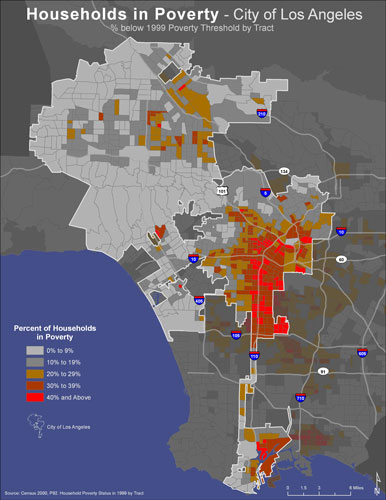Poverty adversely affects the lives of Los Angeles residents as well as the City as a whole. Among other things, poverty has a direct financial impact on local government because of above-average per capita costs for municipal services related to police and fire protection, courts, education, and other services in poor neighborhoods. Nationally, the number of neighborhoods marked by concentrated poverty and the number of people living in such acutely poor neighborhoods has declined. Los Angeles is one of only two major U.S. metropolitan areas in which concentrated poverty became more prevalent between 1990 and 2000.
This analysis of concentrated poverty (census tracts in which 40 percent or more of households were below the poverty level in 2000) found that neighborhoods with concentrated poverty are clustered in a corridor extending from downtown-adjacent neighborhoods to South Los Angeles.
- Eight percent of the tracts in the City have concentrated levels of poverty. These tracts are home to over 270,000 residents.
- Residents of concentrated poverty neighborhoods (CPNs) are disproportionately Latino and Black. They also are largely foreign-born and face language barriers.
- The proportion of residents in CPNs who are working-age is comparable to that in the City as a whole, but residents of CPNs are less likely to be employed and more likely to be out of the labor force.
The wide-spread impacts of concentrated poverty are revealed by a variety of indicators of social wellbeing. CPNs are 63 percent more adversely impacted than the City as a whole as measured by:
– Housing insecurity
– Young adults at-risk
– Immobility
– Maternal health outcomes
– Educational attainment
– Public safety
– School performance













